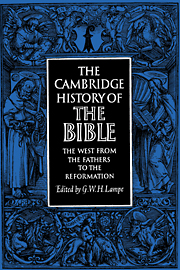Book contents
- Frontmatter
- I The Old Testament: Manuscripts, Text and Versions
- II The History of the Text and Canon of the New Testament to Jerome
- III Early Christian Book-Production: Papyri and Manuscripts
- IV Jerome
- V The Medieval History of the Latin Vulgate
- VI The Exposition and Exegesis of Scripture
- VII The ‘People's Bible’: Artists and Commentators
- VIII Bible Illustration in Medieval Manuscripts
- IX The Vernacular Scriptures
- X Erasmus in Relation to the Medieval Biblical Tradition
- Bibliography
- Notes on the Plates
- Index
- References
III - Early Christian Book-Production: Papyri and Manuscripts
Published online by Cambridge University Press: 28 March 2008
- Frontmatter
- I The Old Testament: Manuscripts, Text and Versions
- II The History of the Text and Canon of the New Testament to Jerome
- III Early Christian Book-Production: Papyri and Manuscripts
- IV Jerome
- V The Medieval History of the Latin Vulgate
- VI The Exposition and Exegesis of Scripture
- VII The ‘People's Bible’: Artists and Commentators
- VIII Bible Illustration in Medieval Manuscripts
- IX The Vernacular Scriptures
- X Erasmus in Relation to the Medieval Biblical Tradition
- Bibliography
- Notes on the Plates
- Index
- References
Summary
PREHISTORY OF THE CHRISTIAN BOOK: PAPYRUS AND PARCHMENT
The discoveries of the present century have completely revolutionized our ideas of the early Christian book and its ancestry. Handbooks written thirty years ago, or even less, are now largely obsolete, and it is only today that it is becoming possible to envisage the basic problems which have still to be solved. This advance in knowledge has been all the more dramatic because no early Christian writer has anything to tell us about the way in which Christian, or indeed any, books were written and circulated. Nor are pagan writers of the contemporary Graeco-Roman world much more informative: in common with the general paucity of technological literature, no treatise on ancient book-production has come down to us, and we have had to glean what knowledge we could from casual references and allusions, often incomplete or ambiguous.
Now, however, the picture is altered to the extent that finds of papyri, predominantly in Egypt, have provided us with hundreds of specimens of works of literature produced during the period in which Christian literature was born: and, still more recently, the astonishing discoveries in the deserts of Palestine have revealed numerous examples of the types of books and writing materials with which the earliest members of the Church would have been familiar and which they would have used themselves in daily life.
Three distinct types of writing material, papyrus, parchment, and wooden tablets, contributed, though in very different ways, to the formation of the Christian book, and all were in common use in Palestine and most of the Near East during the first century A.D. The first which we shall consider is papyrus.
- Type
- Chapter
- Information
- The Cambridge History of the Bible , pp. 54 - 79Publisher: Cambridge University PressPrint publication year: 1969
References
- 4
- Cited by

